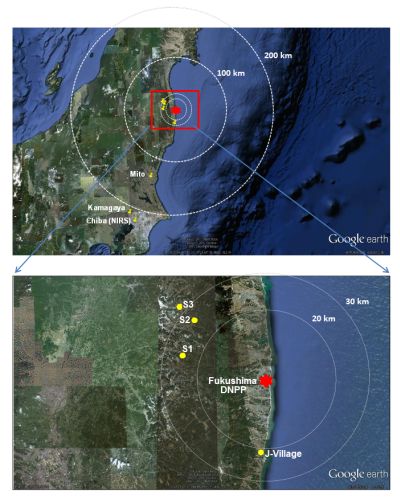放射線医学総合研究所(千葉市)は、東京電力福島第1原発から北西や南に20~32キロ離れた福島県内の3地点で、事故で放出されたとみられるプルトニウム241を初めて検出したと、8日付の英科学誌「サイエンティフィック・リポーツ」の電子版に発表した。
人体に影響のないレベルだが、プルトニウム241は他の同位体に比べて半減期が14年と比較的短く、崩壊してできるアメリシウム241は土壌を経由して主に豆類に取り込まれやすい。放医研は「内部被ばくを避けるためにも 原発20キロ圏内での分布状況を確かめる必要がある」としている。
昨年4~5月に採取した福島県飯舘村、浪江町の森林の落ち葉と、スポーツ施設で現在事故対応拠点となったJヴィレッジ(広野町など)の土から検出。他の同位体プルトニウム239(半減期2万4千年)、240(同6600年)も検出 、同位体の比率から今回の事故が原因と分かった。
濃度は、過去に行われた大気圏内核実験の影響により国内で検出されるプルトニウム241よりも高い。ただ半減期が短く、1960年代当時に核実験で飛来した濃度よりは低いレベルという。
プルトニウムは天然にはほとんど存在しない放射性物質で、原子炉では燃料のウランが中性子を吸収してできる。
(共同通信)
2012/03/08 23:07
原発事故で拡散、プルトニウム241初検出
東京電力福島第一原子力発電所事故で拡散したとみられるプルトニウム241を、放射線医学総合研究所などが福島県内で初めて検出した。
文部科学省による昨年9月の調査結果では、同位体のプルトニウム238、239、240を検出していたが、241は調査対象外だった。英国の科学電子雑誌に8日、発表した。
研究チームは浪江町、飯舘村のほか、広野と楢葉の両町にまたがるJヴィレッジの3か所から採取した土壌や落ち葉から、241(1キロ・グラムあたり4・52~34・8ベクレル)を検出した。241は国内ではほとんど検出されないため、原発事故で拡散したと結論づけた。
最大濃度の落ち葉が採取された場所の今後50年間の被曝(ひばく)線量は0・44ミリ・シーベルトと試算され、健康影響はほとんどないと研究チームはみている。ただ、241が崩壊して生じる放射性物質のアメリシウムは植物へ移行しやすいという研究もあり、「継続調査が必要だ」としている。文科省は241を調査から外した理由について、「検査に時間がかかるため、同じベータ核種のストロンチウムを優先した」と説明している。
(2012年3月9日08時04分 読売新聞)
2012年3月8日23時3分
20~30キロ圏でプルトニウム241 原発事故原因か
放射線医学総合研究所などのグループが東京電力福島第一原発から20~30キロ付近の土壌からプルトニウム241を検出した。この核種は半減期が14.4年であることなどから、1960年代を中心に行われた大気圏内での核実験ではなく、昨年の事故で原発の原子炉から放出されたと考えられるという。8日付の科学誌サイエンティフィック・リポーツ電子版で報告した。
放医研の鄭建(ツン・ジェン)主任研究員らは、福島県葛尾村(原発の西北西25キロ)と浪江町(北西26キロ)、飯舘村(北西32キロ)、楢葉町のJヴィレッジ(南20キロ)、水戸市(南西130キロ)、千葉県鎌ケ谷市(南西230キロ)、千葉市(南西220キロ)で土壌を採取し分析した。
その結果、浪江町と飯舘村の落葉の層から1キロあたりそれぞれ34.8ベクレルと20.2ベクレル、Jヴィレッジの表土から1キロ当たり4.52ベクレルのプルトニウム241を検出した。プルトニウム241は、アルファ線やガンマ線を出すアメリシウム241(半減期432.7年)に変わる。
研究グループの田上恵子・放医研主任研究員は「大気圏内核実験が盛んに行われていた1963年当時の放射性降下物のデータから推定すると、今回のプルトニウム241の検出量は当時と同程度かそれ以下。特別な対策は必要ない」と話す。
Nature News Blog
Plutonium spotted far from Fukushima
08 Mar 2012 | 14:11 GMT | Posted by Geoffrey Brumfiel | Category: Fukushima, Health and medicine, Natural disasters

A paper out today in the journal Scientific Reports shows evidence that radioactive plutonium spread tens of kilometres from the Fukushima Daiichi nuclear plant. The new work could lead people to believe that there is a health risk, but that is not the case.
Plutonium is a radioactive element that is made inside nuclear reactors. Unlike some of the other contaminants to come from Fukushima, it is not volatile, and it is much harder for plutonium to escape from a nuclear reactor during a meltdown. That doesn’t mean it can’t happen: when Chernobyl’s Unit 4 reactor exploded in 1984, it released a large quantity of plutonium into the surrounding environment.
Plutonium can be dangerous. When it decays, it usually releases heavy particles such as electrons and helium nuclei. These particles aren’t particularly dangerous outside the body, but if plutonium is ingested they can cause genetic damage.
The new paper shows that minute quantities of plutonium from Fukushima have spread far from the plant. In samples taken to the northwest and in the J-Village, where workers live, the authors found trace amounts of plutonium in the surface soil (see map). Looking at the ratio of plutonium-241 to plutonium-239, they were able to conclude that the plutonium came from Fukushima rather than other sources, such as old nuclear-weapon tests.
The additional exposure from inhaling this loose plutonium at the S2 site is around 0.5 millisieverts (mSv) over 50 years.
This dose — 0.5 mSv over half a century — is five times higher than the government’s current estimate for plutonium exposure from the accident, but it doesn’t mean there’s a health risk. Over the same period, the average person on Earth would receive 120 mSv from natural sources of radiation. Even for those who worry about low-dose radiation, it’s safe to say that this additional plutonium exposure won’t have an impact.
Nevertheless, the measurements are interesting. The distances at which the team finds the material imply that plutonium was ejected during the hydrogen explosions in the first days of the crisis. And the relatively low levels (around 10,000 times lower than Chernobyl) suggest that the heavily shielded concrete casings around the reactors did offer some protection from the worst of the fallout.
There’s another reason this work is important. As we report this week, mistrust is running high among residents in Japan. Independent measurements such as these are extremely important in providing residents and evacuees with the information they need to get on with their lives. In this case, the measurements show little additional risk. But news of plutonium, no matter how small, will no doubt be dispiriting to the residents of Fukushima.



